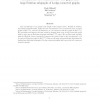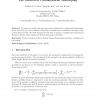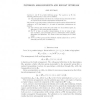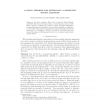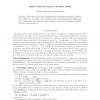114
click to vote
JCT
2011
14 years 3 months ago
2011
Abstract. Norton and Stein associated a number with each idempotent quasigroup or diagonalized Latin square of given finite order n, showing that it is congruent mod 2 to the tria...
JCT
2011
14 years 7 months ago
2011
The circumference of a graph is the length of its longest cycles. Results of Jackson, and Jackson and Wormald, imply that the circumference of a 3-connected cubic n-vertex graph i...
80
Voted
JCT
2011
14 years 7 months ago
2011
87
Voted
JCT
2011
14 years 7 months ago
2011
104
Voted
JCT
2011
14 years 7 months ago
2011
We present a method for proving q-series identities by combinatorial telescoping in the sense that one can transform a bijection or classification of combinatorial objects into a ...
92
Voted
JCT
2011
14 years 7 months ago
2011
Let W be a finite reflection group. For a given w ∈ W, the following assertion may or may not be satisfied: (∗) The principal Bruhat order ideal of w contains as many elemen...
93
Voted
JCT
2011
14 years 7 months ago
2011
Given a simple graph G, the graph associahedron KG is a simple polytope whose face poset is based on the connected subgraphs of G. This paper defines and constructs graph associah...
84
Voted
JCT
2011
14 years 7 months ago
2011
102
click to vote
JCT
2011
14 years 7 months ago
2011
The neighborhood of a pair of vertices u, v in a triple system is the set of vertices w such that uvw is an edge. A triple system H is semi-bipartite if its vertex set contains a ...
77
Voted
JCT
2011
14 years 7 months ago
2011

